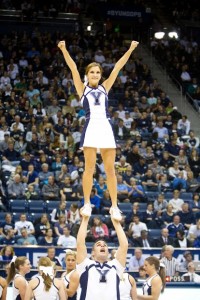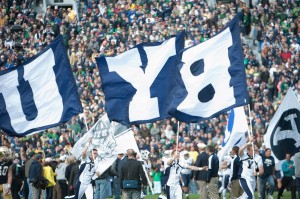The BYU cheerleaders sat on the playing floor of the Smith Fieldhouse at 7 a.m. on Wednesday morning and stretched to prepare for practice.

Head coach Jocelyn Allan gathered the squad and started practice with a backflips warmup. Every member of the team must perform — and stick the landing of — a standing backflip.
“If you stick it, you can sit down,” Allan said.
After the backflips, they lined up and performed tumbling routines across the floor. Eventually they had warmed up enough and started practicing stunts and routines. Female cheerleaders supported other cheerleaders on their shoulders, and squad members suspended six feet in the air hoisted others above their own heads.
Allan said there is no doubt that her cheerleaders are athletes.
“Is (cheerleading) a sport right now?” she said. “No, I would say it’s not a sport, but is it athletic? Yes, absolutely. … Are these kids competing at a national level? Are they putting their bodies through majorly athletic skills? Yes, absolutely.”
As she described what she looks for at tryouts, she motioned to a young woman flipping across the floor and said she looks for athletic ability, skills in gymnastics and the capability to perform in front of a crowd.
These students are athletic, but most of their time is spent performing in front of other teams’ crowds. They compete once a year in January, but there is no organized team to cheer on their own sidelines.
However, a national movement has surfaced that would make cheerleading an NCAA-sanctioned sport. Stunt is the name of the movement, and its purpose is to make cheerleading all about competition.
“Stunt removes the crowd-leading element and focuses on the technical and athletic component of cheer,” according to the College Stunt Association website.
In other words, Stunt separates the competitive stunting aspect of cheer from the traditional, stereotypical cheerleader role of leading crowds at athletic events. A Stunt team’s primary activity is preparing for and entering its own competitions. On its website, Stunt is described as a “new, competitive team sport derived from cheerleading.”
A stunt team is not in BYU’s near future, Allan said, because one of her squad’s main focuses is to cheer for other teams. Back at practice, she made some announcements and assigned cheerleaders to be at basketball games over Christmas break.
To questions and skeptical looks, she responded, “It’s not just our stuff. We have to go to everybody else’s stuff, too.”
Those words seem to illustrate her general attitude. While she enthusiastically acknowledges the competitive talent of the students on the squad, she is also loyal to sideline cheering.

“I think a huge part of what we do is supporting the other teams, and I don’t want to lose the traditional meaning of cheerleading,” she said. “For this team, our main purpose is to support the athletic department and the other athletic events. Our side purpose is to be able to compete on a national level and to do well.”
The two-time national champions somehow manage to fulfill both those roles, cheering at all football, basketball and women’s volleyball games all while preparing for nationals, which hit right in the middle of basketball season.
Timpanogos High School Head Cheer Coach Lauren Egbert has a view similar to Allan’s. She said her squad’s stunting isn’t as intricate as it could be if she focused solely on competition routines.
“I will always consider cheer a sport,” she said. “On my squad we are first academic students. Second, we are here to cheer on our school, and lastly we compete for ourselves. … We will first always focus on our school teams and cheering for them. Then, if as a squad we have proven that we can take on the responsibility of competing, we will compete.”
The BYU cheerleaders themselves share Allan’s sense of priorities, too. Senior captain Sam Lund said she loves cheerleading, both in competition and on the sideline, because she loves to perform.
“I feel like we add something to the atmosphere at a game,” she said. “If we weren’t there, of course the game would still be fun, but we add that little extra exciting thing. … If we weren’t there I don’t think those things would happen spontaneously.”
Lund’s teammate and fellow captain, Anna Richey, grew up participating on solely competition teams, and she said she loves that aspect. She said she recognizes the value of what cheerleaders add to the atmosphere at other events.
“If you think of a football game, you think (that the) football team and cheerleaders are going to be there, and it’s going to be fun,” she said. “We add a lot to the atmosphere of a football game or a basketball game.”
Cameron Larsen, a senior on the squad who also works for the cheer apparel company Varsity, said that while a Stunt team wouldn’t necessarily eliminate a traditional cheer squad, BYU would likely prioritize the traditional role of cheerleaders.
“That’s our number one purpose, and our coach instills that in us all the time,” he said. “Yes, we do get to do these other activities, and we do get to compete … but this cannot take the place of cheering at games. To me, it’s being the ambassadors for the university, it’s being examples to everyone in athletics, and it’s always taking pride in the program that we’ve built and taking pride in BYU.”
These athletes are competitors, and they thrive on competition; but they most often use their athleticism to enhance the competitions of other teams.




